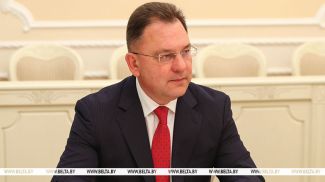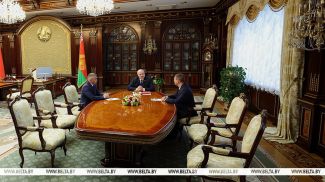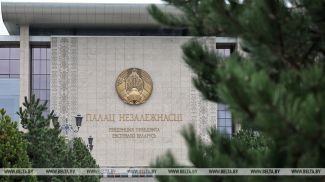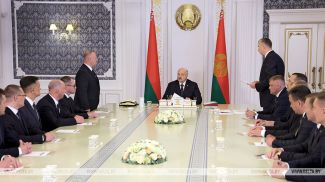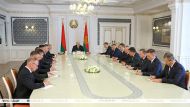The Collective Security Treaty became 30 years old in 2022. This military and political alliance began to take shape almost on the ruins of the Soviet security system and turned into an ambitious international organization ten years later. What countries refused to extend the agreement and what is happening in the Collective Security Treaty Organization now? Why is the organization criticized and held up as an example? And why will the CSTO never become an analogue of NATO? BelTA's YouTube project After the Fact: Lukashenko's Decisions finds it out.
When was the Collective Security Treaty signed?
The Collective Security Treaty was signed in Tashkent on 15 May 1992. It was signed by the leaders of Armenia, Kazakhstan, Kyrgyzstan, Russia, Tajikistan, and Uzbekistan. Azerbaijan, Belarus, and Georgia acceded to the treaty the next year. After completion of the national ratification procedures the Collective Security Treaty came into force on 20 April 1994.
The key fourth article of the treaty reads: “If one of the states is subjected to aggression (armed assault that threatens security, stability, territorial integrity, and sovereignty), then all signatory states will view it as aggression (armed assault that threatens security, stability, territorial integrity, and sovereignty) against all the states parties to the treaty."
The countries undertook to provide partners with the necessary military assistance and support in this case. But things turned out to be not so simple in practice. More on this later.
How many countries does the CSTO consist of?
The treaty was concluded for five years with the possibility of extension. And in 1999 its signatories signed the corresponding protocol. All of them did except Azerbaijan, Georgia, and Uzbekistan. They decided to concentrate their efforts in GUAM, an organization they created to promote democracy and economic development. It aimed for integration into European and Euro-Atlantic structures. Including NATO. But GUAM's activity faded over time. Meanwhile, the CSTO flourished.
In 2002 the Collective Security Treaty, which had been essentially a regional agreement until then, started evolving into an international organization. At the CIS summit in Chisinau on 7 October the heads of Armenia, Belarus, Kazakhstan, Kyrgyzstan, Russia, and Tajikistan approved the CSTO Charter. The document was registered with the UN Secretariat in December 2003. These countries have been members of the Collective Security Treaty Organization since then.
According to the charter, the CSTO goals are the strengthening of peace, international and regional security, protection of independence, territorial integrity and sovereignty of the member states on a collective basis. The document also defines the principles that guide the CSTO: the priority of political means over military ones; strict respect for independence, voluntary participation; equality of rights and obligations of the member states; non-intervention in matters within national jurisdiction.
Interestingly, in 2006 Uzbekistan returned to the CSTO family. The tense internal political situation coupled with the aggravation of relations with the West forced the country to look for allies among old friends. But this membership was formalistic and Uzbekistan once again withdrew from the alliance after a few years as a result. The official reason is disagreement with strategic plans concerning the direction of Afghanistan. However, many understood that the reasons were completely different. Belarus President Aleksandr Lukashenko repeatedly drew attention to Uzbekistan's duplicity and urged the country to finally decide on its goals.
At a meeting with participants of the session of the Council of the Parliamentary Assembly of the Collective Security Treaty Organization in Minsk in 2011 Aleksandr Lukashenko said: “Although the country maintains a special stance now, even Uzbekistan will ultimately understand that it will be difficult for the country to preserve its independence without the CSTO. We have to make a decision on Uzbekistan. Because the triple play Uzbekistan is playing right now does not allow the country to stay in the CSTO.”
These days Tashkent maintains a more balanced stance and follows the policy of non-participation in any military-political blocs.
The CSTO is a defensive union. What about NATO?
Why can't the CSTO be compared to NATO? The countries of the North Atlantic Alliance have a single political direction. The main enemies are Russia and China. For the sake of ephemeral confrontation nuclear weapons have been deployed in Europe. And more and more military bases have been set up in the countries bordering Russia and in the vicinity of China. As many as 180 U.S. thermonuclear bombs were kept in Europe several years ago. They were stored at military bases in Belgium, Germany, Italy, Netherlands, and Türkiye. While these bombs may have been moved to other countries, their number has not dwindled. It is likely the number has increased. Pentagon allocates $100 million every year for storing the nuclear potential in Europe in addition to keeping a staff of 3,000 people, who do technical maintenance of the weapons.
Yes, NATO's strategy is supposedly defensive. But just look at these numbers: more than 250 military conflicts have taken place in 153 countries since World War Two and 80% of them are the work of the United States and its accomplices in the alliance. In other words, not a single year has passed since the founding of NATO without military forces of the bloc taking part in an armed conflict in this or that part of the planet. In other words, NATO does not promote peace, but unleashes wars.
Nikolai Buzin, Doctor of Military Sciences, professor, said: “Let's recall Yugoslavia. It was the first time in contemporary history when NATO countries simply destroyed a European country through joint efforts. It was probably the trigger that demonstrated the essence of this organization. The entire world came to realize what NATO is after all.”
The very purpose of creating NATO explains everything. It was voiced by NATO's first Secretary General, British general Hastings Lionel Ismay: to keep the USSR out of Europe, to keep Americans in Europe, and to keep the Germans down. And do you remember the promises of the alliance not to expand to the east? This is the kind of promises such an alliance can give.
Nikolai Buzin stressed: “NATO has never been a defensive union after the collapse of the Soviet Union. It had no adversaries for many years. NATO's crisis, which only got worse in the last few years, has been overcome only thanks to the launch of combat operations in Ukraine. This event revitalized NATO. Many experts agree it was an action meant to revive NATO as a military and political force. As a matter of principle, the goal has been accomplished. Now NATO has a genuine adversary instead of an imaginary one that they had for many years. Now NATO has the need and justification for building up the military industrial potential and reviving the defense industry.”
Is the CSTO NATO's adversary?
NATO's cohesion and the presence of a leader cannot be denied. It is according to the leader's tune that the other members of the alliance dance. But on the other hand, the countries are building up their military might thanks to the leader. What prevented the CSTO from growing fast? National interests often prevailed over coalition ones. It was the lack of a leading state in the CSTO system for many years that had slowed down the organization's development, explained Andrei Chernobai, a military analyst with the Belarusian Institute for Strategic Research (BISR).
“You shouldn't play off CSTO against NATO and describe them as adversaries. We are not adversaries. Moreover, we are ready for interaction and cooperation with NATO. It was mentioned at a meeting of heads of state among other things. But regretfully it is only our initiative, our desire. We have yet to receive a response from NATO. Although we see how the situation develops and we would like to organize this interaction after all because unusual situations may happen such as the missile incident in Poland. We can see what may happen in the absence of communication, interaction even between Russia and NATO,” Andrei Chernobai said.
What did Lukashenko criticize the CSTO for?
The CSTO is a more multifaceted and complex organization. Each state has its own problems. Russia is concerned about actions of the United States and its allies aimed at undermining the international security architecture. Belarus is concerned about NATO expansion and growing tensions along western borders. Kazakhstan, Kyrgyzstan, and Tajikistan are concerned about the situation in Afghanistan, which means on the southern borders of Central Asia. Armenia has a direct confrontation with Azerbaijan.
And troubles happen when personal interests begin to dominate over common goals. Throughout its history the CSTO has repeatedly faced an internal crisis of confidence. Kyrgyzstan has turned to partners for help three times only to get denied each time. Armed Islamists from Afghanistan and Tajikistan invaded the country in 1999. A bloody inter-ethnic conflict between Kyrgyz and Uzbeks happened in 2010. A violent armed conflict happened at the Tajikistan-Kyrgyzstan border in 2021.
In addition, according to Aleksandr Lukashenko, the CSTO could have intervened in the situation and could have prevented a coup in Kyrgyzstan in 2010. Not for the sake of saving the political leadership of the country. The head of state believed that the West would not directly fight against the CSTO countries, but would try to undermine the situation from within, including according to the Arab spring scenario. The January events in Kazakhstan confirmed it.
“I've been recently speaking up about this organization, particularly in view of the latest events. What kind of an organization is it when blood is spilt, a coup happens in one of our countries and there is only silence? Why? It is easy to guess why judging from these events,” the Belarus president remarked in 2010.
Why doesn't the CSTO interfere in the conflict between Armenia and Azerbaijan?
While the CSTO's non-intervention in Kazakhstan's affairs can be explained by the absence of valid reasons, by saying that all the events were domestic, then why does the organization fail to respond to Armenia's requests? The country is in an open conflict with Azerbaijan right now. This war claimed lives of 6,500 Armenian and Azerbaijani servicemen in 2020. The conflict was frozen thanks to Moscow's mediation. But it has made itself felt again this year. Fierce and senseless battles raged along the Armenian-Azerbaijani border for two days, on 13 and 14 September. Lives were lost.
Do you remember the fourth article of the Collective Security Treaty? “If one of the states is subjected to aggression, then it will be construed as aggression against all parties to the treaty.” So why doesn't the CSTO intervene in the situation to protect its partner? Life is sometimes much more complicated than agreements, laws, and rules. It does not mean that they should be broken. But they should not be applied bluntly either. This is why the organization prioritizes political means over military ones.
At an extraordinary session of the CSTO Collective Security Council, which was convened upon Armenia's request on 28 October, Aleksandr Lukashenko dotted all the i's. Without saying a word from the prepared theses, the head of state answered all the questions hanging in the air. Directly and without prevarication as always.
“The issue is very sensitive and delicate. It is not like the CSTO and we, CSTO members are on one side while Azerbaijan is on the other side. The two countries are friendly to us. I confirm President Putin's words that Armenia and Azerbaijan are kindred countries for us. It is a peculiarity of the situation. We cannot but take it into account,” the head of state stressed.
How can the Armenia-Azerbaijan conflict be resolved?
Armenia and Azerbaijan were part of one country once. Now they are friendly countries for all states in the CIS space. Moreover, Aleksandr Lukashenko believes, the conflict needs to be resolved now while Ilham Aliyev is in power in Azerbaijan. He is a leader you can negotiate with.
“You've raised two matters before us. The first one is the evaluation of events and the CSTO stance. You demanded that we must determine our stance. Don't you know our stance? We would like the neighboring countries to resolve the conflict by peaceful means. The second matter is ‘Make a roadmap on restoring Armenia's territorial integrity'. What roadmap? I can tell you right away: get in touch with Ilham Aliyev, ask the president of Russia if you need to, and make a decision. If you don't make one today, things will be worse! You understand it yourself! We don't need this conflict!” Aleksandr Lukashenko pointed it out at the summit on 28 October.
But it would be wrong to say that the Collective Security Treaty Organization stays away from the conflict between Armenia and Azerbaijan. A mission headed by the organization's Secretary General Stanislav Zas and Chief of the CSTO Joint Staff Anatoly Sidorov was sent to Armenia in September. The mission was instructed to assess the situation and prepare a detailed report with proposals for de-escalating the tensions.
Nikolai Buzin believes: “Armenia was not left to deal with its problems on its own. The country got help in the period of the conflict's escalation. But all the rest and today's steps should proceed within the framework of a political dialogue. The use of military force is an extreme step that should be used as the last resort. We have yet to reach such a state.”
Where were CSTO troops used?
The CSTO leaders had to use their military forces only once. Bloody protests erupted in Kazakhstan in early 2022. And in the evening on 5 January Kassym-Jomart Tokayev turned to his CSTO colleagues with a request for peacekeeping support. He explained it was needed due to the presence of terrorist units, who had been trained abroad and were operating in the country. At night the chairman of the Collective Security Council, Armenian Prime Minister Nikol Pashinyan announced that the organization would send collective peacekeeping forces to Kazakhstan. And the first few units arrived in Kazakhstan as early as on 7 January. The main goal of the CSTO peacekeeping contingent was to protect important state and military facilities, to assist local law enforcement with stabilizing the situation and with restoring law and order.
This CSTO operation received a lot of attention. Western partners were struck not so much by its scale as by the decisiveness of the presidents and the prompt deployment of forces. It turned out that it was easy for the CSTO to form a military transport aviation group of 80 aircraft in a day and to transfer more than 2,000 military personnel and 250 units of equipment from five countries to Kazakhstan within a couple of days.
Nikolai Buzin remarked: “It was quite a serious shock for representatives of Western elites, who saw there is a force in the post-Soviet space that can take care of security of the member states. It was a serious demonstration of capabilities of the CSTO's military component.”
When the peacekeeping contingent returned from Kazakhstan to Minsk, Aleksandr Lukashenko welcomed the personnel and stressed that the measures taken within the framework of the Collective Security Treaty Organization had made it possible to save Kazakhstan and prevent the situation from developing according to the most negative scenario and had not allowed another color revolution to flare up.
“You have shown everyone that it is dangerous to fight against us. Moreover, it is impossible. It is impossible to defeat us .It is the main result of your operation,” the president said. “Everything that happened in Almaty would have happened throughout Kazakhstan. The redeployment of a contingent of CSTO countries in the shortest possible time eliminated the threat of destruction of the state, ensured the stabilization of the situation and the restoration of constitutional order in the country.”
What other functions does the CSTO perform?
Military security is not the only task of the organization. From a purely military-political bloc, the CSTO is turning into a multirole platform. The CSTO collective forces are called upon to fight transnational organized crime, drug trafficking, and help alleviate consequences of natural and man-made emergencies. They are called upon to resist illegal migration, cybercrime, and the inciting of information wars. These are not large-scale military operations, but pinpoint operations, so reports about them are not always released to the general public.
For example, since 2003 the CSTO has been conducting the anti-drug operation Kanal, cutting off the supply of drugs and psychotropic substances to the region. Belarus supervised the operation at the end of September. Almost 10,000 representatives of law enforcement agencies, border services, and customs services, state security services, and financial intelligence units were involved in the operation.
The operation resulted in seizing more than 430kg of narcotics, detecting 361 drug crimes, and exposing 41 drug gangs. 298 people faced administrative charges for illegal operations with drugs. 43 firearms and about 2,500 rounds of ammunition were confiscated. Financial intelligence units identified 1,300 suspicious financial transactions. All of it after a few days' work. Over 10 tonnes of illegal drugs are often seized as a result of the operation per year.
Andrei Chernobai, a military analyst with the Belarusian Institute for Strategic Research, remarked: “This year is probably the most complicated one in the entire 20-year-long history of the CSTO and the 30-year-long history of the treaty. Because all the six CSTO member states were involved in various crisis situations. Belarus is going to preside over the Collective Security Treaty Organization next year. We know many initiatives put forward by Minsk, some of them have been realized. The president has put forward a number of other vital initiatives. Belarus will most probably have to realize these initiatives during its presidency and set an example for other countries. Complicated decisions may have to be made. Because we see how the situation in the CSTO's responsibility areas develops in complicated ways.”
Now almost all countries of the world are in military blocs. Even Australia and New Zealand have teamed up with the USA to bolster their security. Under the agreement they even took part in the Afghan operation and the Iraqi campaign. And they undertake to join the United States if America gets into a hypothetical war for Taiwan.
Therefore, today only very self-confident countries can afford staying outside any military alliances. While countries, which are at the crossroads of all roads like Belarus, have no choice. And Belarus' choice is obvious.




